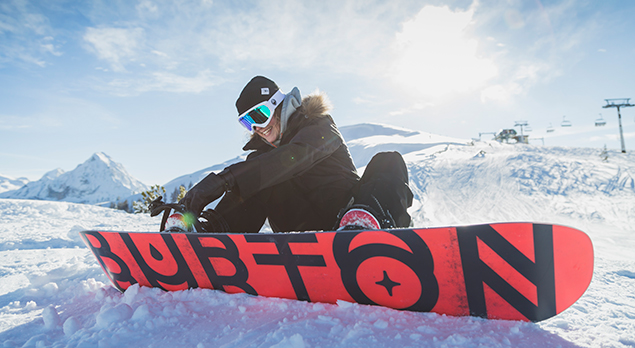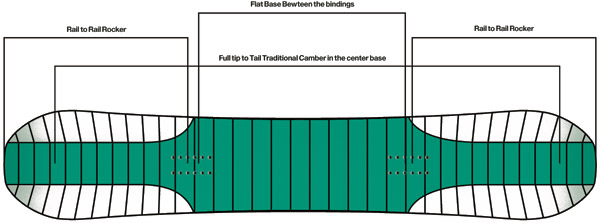Tech Series - Snowboard Profiles

With recent advances in materials, technology and manufacturing processes snowboard design has come a long way since the original Snurfers. The profile (base contours) of snowboards have seen some dramatic developments since the first reverse camber board was released in 1996, the Skate Banana.
Most modern snowboards have profiles that can be placed into one of 6 different categories.
- Camber
- Rocker
- Flat
- Hybrid
- Camber Rocker
- Triple Base
Camber

Rider level: Intermediate – Advanced
Terrain: Piste, All mountain
Camber refers to the curved contact area of the base at the tip and tail of the board - imagine a subtle rainbow shape, that is what the board looks like when lying flat. This shape creates a stable riding platform and a large part of board-edge grips into the snow, resulting in for feel-good carves.
Another benefit of the shape is that when you press down into an ollie the board bends against this motion resulting in more pop. One downfall is that unless the board is travelling completely flat the edges can of dig into the snow resulting in a fall.
![]()
Rocker

Rider level: Beginner – Intermediate
Terrain: Backcountry, Park
Rocker is essentially the opposite of camber. Picture a mildly kinked U or V shape when the board is laid on a flat surface.
The ends of the board naturally rise up away from the snow producing extra lift in powder and catch free edges – very useful for beginners and use in the park. Raised ends mean that less of the board is in contact with snow resulting a twitchy feeling at high speeds and less aggressive turns.
![]()
Flat

Rider Level: Beginner – Advanced
Terrain: All mountain, Backcountry, Park
A board with flat or zero camber will lay flush on a level surface and spreads pressure evenly across the snow. This creates a “loose” and “catch-free” ride similar to reverse camber while remaining relatively more stable and predictable.
Because most of the board is in contact with the snow there is more drag and a slightly slower ride so if you want speed this might not be profile for you.
![]()
Hybrid

Rider Level: Beginner – Advanced
Terrain: All mountain, Backcountry, Park
Hybrid camber combines various elements of camber and rocker, these are usually standard rocker out from the centre section of the board blending into camber under the feet then reverting back to rocker beyond the binding area.
This profile has a fun loose feel for the park and is easy to press/butter yet retains most of the stability of a traditional camber board.
![]()
Camber / Rocker

Rider Level: Beginner – Advanced
Terrain: All mountain, Backcountry, Park
The Camber/Rocker hybrid features camber between the feet which then blends into rocker from the binding points out.
The rocker parts add lift in powder and reduce the chance of catching and edge, whilst the camber underfoot adds pop and stability at high speed.
![]()
Triple Base

Rider Level: Beginner – Advanced
Terrain: All mountain, Backcountry, Park
When you look at a triple base board the main running area of the base is flat and it utilises a traditional camber. However the difference between triple base and all other boards is that from beyond the binding area the base divides into three planes - a left side-base to turn left, a centre-base section to go straight and a right side-base to turn right.
The turned up side-bases help you avoid catching a edge whilst you keep all the performance and control of a traditional camber board.
If you want any more info on board profiles drop into your local TSA shop for a chat : ) .



